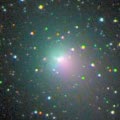
|
Now it is so bright as 8.3 mag (Aug. 31, Juan Jose Gonzalez). It will be observable at 8-10 mag in good condition for a long time until late autumn.
Date(TT) R.A. (2000) Decl. Delta r Elong. m1 Best Time(A, h)
Sept.12 19 33.21 8 29.3 2.545 3.194 121 8.4 20:06 (180, 47)
Sept.19 19 25.51 5 17.3 2.656 3.208 114 8.5 19:31 (180, 50)
|
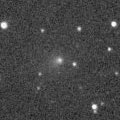
|
Now it is so bright as 9.8 mag (Aug. 21, Juan Jose Gonzalez). It keeps observable for a long time until 2010 February. It will keep 9 mag until the end of 2009. But in the Northern Hemisphere, it keeps very low after this. It locates a bit higher in the Southern Hemisphere.
Date(TT) R.A. (2000) Decl. Delta r Elong. m1 Best Time(A, h)
Sept.12 15 9.98 -19 55.3 1.575 1.404 61 9.3 19:12 ( 94, 42)
Sept.19 15 31.88 -21 31.2 1.587 1.388 59 9.1 19:18 ( 91, 41)
|
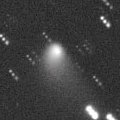
|
It brightened up to 9.8 mag on June 13 (Marco Goiato). Now it is not observable. But it keeps as bright as 10-11 mag for a long time untio 2010 spring. In the Northern Hemisphere, it will appear in the morning sky in early October, then it keeps observable at 10 mag in good condition for a long time. In the Southern Hemisphere, it will locate extremely low only after this.
Date(TT) R.A. (2000) Decl. Delta r Elong. m1 Best Time(A, h)
Sept.12 10 12.50 5 23.7 3.214 2.270 16 9.6 4:40 (267, -5)
Sept.19 10 25.82 6 2.6 3.176 2.261 20 9.6 4:30 (266, -4)
|
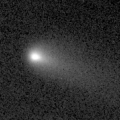
|
It is already so bright as 9.9 mag (Aug. 31, Juan Jose Gonzalez). It will be observable at 10-11 mag in a good condition for a long time from summer to winter.
Date(TT) R.A. (2000) Decl. Delta r Elong. m1 Best Time(A, h)
Sept.12 4 52.00 -3 49.6 0.581 1.225 97 10.8 4:40 (202, 57)
Sept.19 5 14.24 -4 6.8 0.586 1.231 97 10.7 4:30 (204, 57)
|
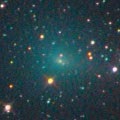
|
It brightened up to 8.8 mag in May and June (May 19, Juan Jose Gonzalez). Now it is still bright as 10.4 mag (Aug. 31, Juan Jose Gonzalez). It will be bright at 9-10 mag for a long time until autumn.
Date(TT) R.A. (2000) Decl. Delta r Elong. m1 Best Time(A, h)
Sept.12 22 41.08 -15 27.0 0.916 1.907 165 11.0 23:14 (180, 70)
Sept.19 22 38.38 -15 47.4 0.975 1.943 158 11.3 22:44 (180, 71)
|
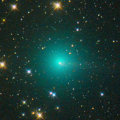
|
It brightened up to 6.7 mag in June (June 9, Marco Goiato). It faded down to 9.5 mag on Aug. 21 (Juan Jose Gonzalez), then it became unobservable. Now it is not observable. But it will appear in the morning sky again at 13 mag in November. It may be visible visually again.
Date(TT) R.A. (2000) Decl. Delta r Elong. m1 Best Time(A, h)
Sept.12 12 55.21 5 4.5 2.952 2.070 23 11.1 19:12 ( 97, 1)
Sept.19 12 59.23 5 53.0 3.039 2.114 18 11.4 19:18 ( 93, -6)
|
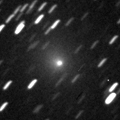
|
It brightened up to 8.5 mag in May and June (May 26, Juan Jose Gonzalez). Now it is fading, but still bright as 10.7 mag (Aug. 22, Marco Goiato). It will never be observable again in the Northern Hemisphere. In the Southern Hemisphere, it keeps observable for a long time after this in the evening sky.
Date(TT) R.A. (2000) Decl. Delta r Elong. m1 Best Time(A, h)
Sept.12 12 31.62 -49 46.0 2.174 1.818 56 11.1 19:12 ( 45, 25)
Sept.19 13 4.09 -51 48.2 2.262 1.892 55 11.4 19:18 ( 43, 26)
|

|
It was bright as 8-9 mag in April and May. Although it had been unobservable for a while, now it is appearing in the morning sky. It should be bright as 12 mag still now. It will be fading slowly in the low sky after this. In the Southern Hemisphere, it keeps observable in good condition for a long time. H. Sato reported that only a faint doubtful diffuse something was found on the CCD images on Aug. 31. So the comet can be extremely faint now.
Date(TT) R.A. (2000) Decl. Delta r Elong. m1 Best Time(A, h)
Sept.12 8 0.61 -5 10.4 2.718 2.223 50 12.1 4:40 (256, 28)
Sept.19 8 4.56 -8 15.5 2.704 2.297 55 12.3 4:30 (256, 32)
|

|
It must have reached up to 11 mag in summer. However, the condition of this apparition is worst. We can not observe it at all.
Date(TT) R.A. (2000) Decl. Delta r Elong. m1 Best Time(A, h)
Sept.12 11 29.39 10 28.5 2.284 1.289 6 12.8 19:12 ( 89,-20)
Sept.19 11 52.84 8 1.3 2.314 1.322 6 13.3 19:18 ( 85,-20)
|

|
It brightened up to 11 mag in spring and summer. Now it is not observable. It will appear in the morning sky at 15 mag in early 2010. But it locates somewhat low in the Northern Hemisphere.
Date(TT) R.A. (2000) Decl. Delta r Elong. m1 Best Time(A, h)
Sept.12 13 14.93 -8 34.9 3.007 2.210 31 13.4 19:12 ( 88, 13)
Sept.19 13 28.89 -10 4.4 3.053 2.219 28 13.4 19:18 ( 84, 10)
|
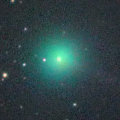
|
It has been observed bright as 8-9 mag from April to June. Now it is fading. It was still bright as 11.0 mag in July (July 12, Marco Goiato). However, no observations have been reported since August. So it may have faded out rapidly. In the Southern Hemisphere, it keeps observable in a good condition for a long time. In the Northern Hemisphere, it will never be observable again.
Date(TT) R.A. (2000) Decl. Delta r Elong. m1 Best Time(A, h)
Sept.12 10 23.64 -50 45.6 2.860 2.450 56 13.7 4:40 (317, 24)
Sept.19 10 30.95 -51 7.4 2.968 2.529 55 13.9 4:30 (316, 25)
|
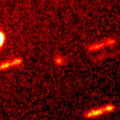
|
Now it is 15.9 mag (Aug. 29, H. Sato). It will be getting higher after this. It will be observable bright as 9-10 mag in a good condition for a long time from winter to spring. It keeps observable until 2010 autumn when it fades down to 16 mag.
Date(TT) R.A. (2000) Decl. Delta r Elong. m1 Best Time(A, h)
Sept.12 8 7.12 18 38.5 2.733 2.213 49 14.3 4:40 (237, 11)
Sept.19 8 21.97 17 54.1 2.632 2.173 52 14.1 4:30 (238, 12)
|

|
Appearing in the morning sky now. No observations have been reported since June 1.
Date(TT) R.A. (2000) Decl. Delta r Elong. m1 Best Time(A, h)
Sept.12 9 19.69 15 36.6 6.993 6.160 31 14.1 4:40 (251, 0)
Sept.19 9 24.30 15 11.1 6.929 6.161 37 14.1 4:30 (249, 3)
|

|
First return of a new bright periodic comet. It was observed as an asteroid in June. Now it is so bright as 12.3 mag (Aug. 31, Juan Jose Gonzalez). In the Northern Hemisphere, it keeps observable in a good condition after this. However, it will fade out rapidly, and will be fainter than 18 mag in October.
Date(TT) R.A. (2000) Decl. Delta r Elong. m1 Best Time(A, h)
Sept.12 8 8.41 21 8.5 0.419 0.801 49 14.2 4:40 (236, 9)
Sept.19 8 12.87 22 41.0 0.484 0.834 55 14.8 4:30 (233, 10)
|

|
It passed near by the earth in late February, and it reached up to 4.9 mag (Feb. 23, Juan Jose Gonzalez). It had been unobservable for a while, but it is appearing in the morning sky again. it is still bright as 13.7 mag and visible visually (Aug. 28, Jakub Cerny). In the Northern Hemisphere, it is observable at 15 mag in good condition from autumn to winter.
Date(TT) R.A. (2000) Decl. Delta r Elong. m1 Best Time(A, h)
Sept.12 7 19.48 20 50.7 3.867 3.487 60 14.4 4:40 (228, 17)
Sept.19 7 18.19 20 49.8 3.816 3.561 67 14.5 4:30 (224, 20)
|

|
Now it is not observable. It will appear in the morning sky again in 2010 February. It will brighten up to 12-13 mag in 2010 summer. But it locates somewhat low in the Northern Hemisphere.
Date(TT) R.A. (2000) Decl. Delta r Elong. m1 Best Time(A, h)
Sept.12 13 37.54 -5 39.0 3.405 2.653 35 14.5 19:12 ( 94, 16)
Sept.19 13 48.25 -6 58.2 3.437 2.637 31 14.5 19:18 ( 90, 12)
|

|
It brightened up to 11.5 mag in last summer (Aug. 4, Marco Goiato). Now it is 15.9 mag (Aug. 12, H. Sato). It keeps observable in good condition for a long time in the Southern Hemisphere. It will be observable again also in the Northern Hemisphere after September. It will keep 15-16 mag until next spring.
Date(TT) R.A. (2000) Decl. Delta r Elong. m1 Best Time(A, h)
Sept.12 6 39.66 -38 49.4 4.123 4.026 77 14.6 4:40 (289, 59)
Sept.19 6 39.80 -39 22.6 4.118 4.076 80 14.7 4:30 (289, 62)
|

|
It brightened up to 9.8 mag in winter (Dec. 28, Juan Jose Gonzalez). It faded down to 12.5 mag in May (May 26, Juan Jose Gonzalez), and became unobservable. It is appearing in the morning sky again. It will be observable in good condition again in winter at 15 mag. Then it may be still visible visually.
Date(TT) R.A. (2000) Decl. Delta r Elong. m1 Best Time(A, h)
Sept.12 9 45.74 13 24.9 5.333 4.442 25 14.7 4:40 (256, -4)
Sept.19 9 51.55 12 34.2 5.335 4.496 30 14.8 4:30 (256, -1)
|

|
Now it is 15.2 mag (Aug. 3, H. Sato). It passes the perihelion in September, and now it is brightest. It keeps observable in good condition in the Southern Hemisphere. It is not observable now in the Northern Hemisphere. But it will appear in the evening sky at the end of September, and then it will be getting higher while fading.
Date(TT) R.A. (2000) Decl. Delta r Elong. m1 Best Time(A, h)
Sept.12 16 24.75 -53 36.2 0.759 1.210 85 14.8 19:12 ( 41, 61)
Sept.19 17 16.56 -50 6.3 0.749 1.217 86 14.8 19:18 ( 45, 65)
|
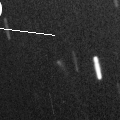
|
Now it is 14.5 mag (July 30, H. Sato). It keeps observable in good condition at 15 mag until late autumn.
Date(TT) R.A. (2000) Decl. Delta r Elong. m1 Best Time(A, h)
Sept.12 0 7.77 27 52.7 3.047 3.922 145 14.9 0:45 (180, 27)
Sept.19 23 58.82 28 48.4 3.030 3.929 149 14.9 0:09 (180, 26)
|
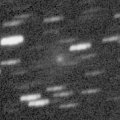
|
Appearing in the morning sky. Now it is 12.8 mag and visible visually (July 25, Juan Jose Gonzalez). It will be getting higher gradually while fading slowly after this.
Date(TT) R.A. (2000) Decl. Delta r Elong. m1 Best Time(A, h)
Sept.12 8 22.42 22 11.8 2.265 1.735 46 14.9 4:40 (237, 6)
Sept.19 8 38.08 20 58.0 2.262 1.783 49 15.0 4:30 (238, 7)
|

|
Now it is 14.9 mag (Aug. 26, H. Sato). It keeps 15 mag until winter. It keeps observable in a good condition in the Southern Hemisphere. But in the Northern Hemisphere, it will be getting lower gradually, and it is only observable until late autumn.
Date(TT) R.A. (2000) Decl. Delta r Elong. m1 Best Time(A, h)
Sept.12 23 57.61 -14 15.9 1.836 2.824 166 15.3 0:35 (180, 69)
Sept.19 23 47.36 -18 44.0 1.819 2.794 162 15.3 23:52 (180, 74)
|
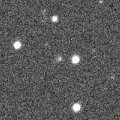
|
Now it is 15.3 mag (Aug. 22, H. Sato). It keeps 15 mag until 2010, and will be observable for a long time in good condition.
Date(TT) R.A. (2000) Decl. Delta r Elong. m1 Best Time(A, h)
Sept.12 15 37.44 39 3.9 3.014 2.788 67 15.3 19:12 (146, 5)
Sept.19 15 33.89 36 35.8 3.091 2.785 63 15.4 19:18 (139, 2)
|

|
Now it is 15.7 mag (Aug. 31, Michael Jager). It will brighten rapidly after this. It will reach to 12 mag and become visible visually in winter. In the Northern Hemisphere, it keeps observable in good condition for a long time after this until 2010 spring when it fades out.
Date(TT) R.A. (2000) Decl. Delta r Elong. m1 Best Time(A, h)
Sept.12 5 8.21 13 18.4 1.889 2.171 91 15.6 4:40 (200, 39)
Sept.19 5 18.85 13 1.8 1.796 2.150 96 15.5 4:30 (198, 40)
|

|
Now it is 16.2 mag (Aug. 13, Ken-ichi Kadota), brightening as expected. It will reach up to 12 mag in 2012, and will be observable visually at 12-13 mag for a long time from 2011 to 2013. In 2009, it is observable in good condition at 16 mag from summer to autumn. In the Northern Hemisphere, the comet will be low around its brightest seasons.
Date(TT) R.A. (2000) Decl. Delta r Elong. m1 Best Time(A, h)
Sept.12 22 9.03 3 26.3 7.569 8.525 160 15.7 22:42 (180, 52)
Sept.19 22 4.55 2 58.8 7.572 8.488 154 15.7 22:10 (180, 52)
|

|
It reached to 10.9 mag in 2008 spring (May 11, Marco Goiato). It is fading slowly, but still bright as 15.0 mag (Aug. 20, H. Sato). Although it becomes low in winter temporarily, it keeps observable for a long time until 2010 spring when it becomes fainter than 18 mag.
Date(TT) R.A. (2000) Decl. Delta r Elong. m1 Best Time(A, h)
Sept.12 16 19.58 30 10.8 5.197 5.027 74 16.0 19:12 (149, 17)
Sept.19 16 24.13 29 28.4 5.305 5.078 71 16.1 19:18 (143, 15)
|

|
Now it is brightest, and it will be fading after October. It keeps observable until January when it becomes fainter than 18 mag. It locates somewhat low in the Northern Hemisphere.
Date(TT) R.A. (2000) Decl. Delta r Elong. m1 Best Time(A, h)
Sept.12 1 29.23 -21 2.1 2.048 2.927 144 16.7 2:06 (180, 76)
Sept.19 1 28.12 -23 12.4 2.033 2.928 147 16.7 1:37 (180, 78)
|

|
It has already passed the perihelion in late June. But unexpectedly, it kept unusual brightening very rapidly after that, and reached up to 15.0 mag on July 30 (D. Chestnov). However, it is fading rapidly after that. It has already faded down to 16.7 mag (Sept. 7, H. Sato). It keeps observable in the evening low sky for a while.
Date(TT) R.A. (2000) Decl. Delta r Elong. m1 Best Time(A, h)
Sept.12 14 55.81 -11 48.5 1.935 1.605 55 16.8 19:12 (101, 35)
Sept.19 15 17.10 -13 19.6 2.015 1.649 54 17.2 19:18 ( 97, 34)
|
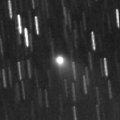
|
It reached up to 12.6 mag and became visible visually in June and July (June 25, Katsumi Yoshimoto). However, it is fading rapidly after August. It has already faded down to 16.8 mag (Aug. 16, Ken-ichi Kadota). It will be fainter than 18 mag in October.
Date(TT) R.A. (2000) Decl. Delta r Elong. m1 Best Time(A, h)
Sept.12 19 19.82 2 11.9 1.095 1.817 119 16.8 19:54 (180, 53)
Sept.19 19 29.29 1 41.6 1.195 1.867 115 17.1 19:36 (180, 53)
|
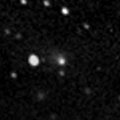
|
It brightened up to 15-16 mag in 2008 summer. Now it is 17.8 mag (Aug. 26, Katsumi Yoshimoto). It keeps observable at 17 mag in good condition for a long time until winter.
Date(TT) R.A. (2000) Decl. Delta r Elong. m1 Best Time(A, h)
Sept.12 3 54.23 31 51.5 2.640 3.070 105 17.0 4:30 (180, 23)
Sept.19 3 56.16 32 35.8 2.568 3.086 111 16.9 4:05 (180, 22)
|
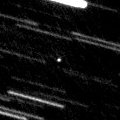
|
It passed the perihelion in June, but it was not observable, too close to the sun. Although it was predicted to be 13.5 mag, the STEREO spacecraft revealed that it brightened up to 10-11 mag, much brighter than expected. Now it is 16.4 mag (Aug. 23, C00). It keeps observable at 16-17 mag until late autumn.
Date(TT) R.A. (2000) Decl. Delta r Elong. m1 Best Time(A, h)
Sept.12 4 10.68 49 17.1 1.101 1.592 97 17.1 4:40 (181, 6)
Sept.19 3 53.95 50 22.1 1.075 1.662 106 17.0 4:03 (180, 5)
|

|
Comet Pigott, which has been lost over 200 years since 1783, is identified with a comet discovered in 2003 by LINEAR. Now it is 17.6 mag (Sept. 11, Catalina Sky Survey). Getting higher, but it will be fainter than 18 mag in October.
Date(TT) R.A. (2000) Decl. Delta r Elong. m1 Best Time(A, h)
Sept.12 7 45.43 43 38.8 2.385 2.099 61 17.2 4:40 (217, -3)
Sept.19 8 3.87 45 4.3 2.349 2.132 65 17.3 4:30 (216, -5)
|

|
Now it is 17.7 mag (Sept. 5, H. Sato). It will reach up to 15.5 mag. It keeps observable in good condition all through the time until next spring when it becomes fainter than 18 mag.
Date(TT) R.A. (2000) Decl. Delta r Elong. m1 Best Time(A, h)
Sept.12 5 16.86 8 18.9 1.132 1.518 90 17.6 4:40 (205, 43)
Sept.19 5 38.85 8 5.7 1.065 1.482 91 17.3 4:30 (207, 43)
|
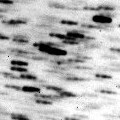
|
Now it is 16.7 mag (Aug. 14, Katsumi Yoshimoto). The condition is good in this apparition. It will approach to the earth down to 0.38 A.U., and will be observable in good condition at 16.5 mag in November. It keeps observable until that time after this. But it locates somewhat low in the Northern Hemisphere.
Date(TT) R.A. (2000) Decl. Delta r Elong. m1 Best Time(A, h)
Sept.12 16 46.20 -18 52.3 0.638 1.127 83 17.5 19:12 (116, 61)
Sept.19 17 2.72 -18 53.8 0.614 1.087 80 17.4 19:18 (111, 58)
|
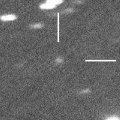
|
It keeps observable at 17 mag for a long time from 2010 to 2012. Now it is 18.5 mag (Aug. 25, W. Hasubick), a bit fainter than this ephemeris.
Date(TT) R.A. (2000) Decl. Delta r Elong. m1 Best Time(A, h)
Sept.12 3 39.71 20 42.4 8.455 8.877 111 17.6 4:16 (180, 34)
Sept.19 3 36.65 20 40.0 8.325 8.860 119 17.6 3:46 (180, 34)
|

|
Now it is 17.3 mag (Aug. 23, Ken-ichi Kadota). It keeps observable at 17-18 mag for a long time until 2011.
Date(TT) R.A. (2000) Decl. Delta r Elong. m1 Best Time(A, h)
Sept.12 4 33.52 70 19.6 5.058 5.156 89 17.6 4:40 (183,-15)
Sept.19 4 30.58 72 8.6 4.966 5.137 94 17.6 4:30 (181,-17)
|

|
Now it is 18.6 mag (Aug. 25, W. Hasubick). It will brighten rapidly after this, and will be observable at 15 mag in good condition in winter and spring. It may be visible visually.
Date(TT) R.A. (2000) Decl. Delta r Elong. m1 Best Time(A, h)
Sept.12 4 59.85 14 18.6 2.347 2.616 93 17.8 4:40 (198, 39)
Sept.19 5 7.11 14 15.6 2.226 2.580 98 17.6 4:30 (194, 40)
|

|
Peculiar asteroid moving along a cometary orbit. It reached up to 17 mag in September and October.
Date(TT) R.A. (2000) Decl. Delta r Elong. m1 Best Time(A, h)
Sept.12 2 13.78 7 38.8 1.246 2.084 135 18.0 2:51 (180, 47)
Sept.19 1 48.44 0 48.5 1.149 2.076 149 17.6 1:59 (180, 54)
|

|
It reached up to 14 mag in 2008 autumn. It is still bright as 16.0 mag (July 30, H. Sato). It keeps observable around 17 mag in a good condition for a while.
Date(TT) R.A. (2000) Decl. Delta r Elong. m1 Best Time(A, h)
Sept.12 22 2.88 15 47.8 4.013 4.926 152 17.6 22:35 (180, 39)
Sept.19 21 53.64 14 42.3 4.091 4.970 147 17.7 21:59 (180, 40)
|

|
Now it is 17.7 mag (Aug. 31, D. Cardenosa and R. Lozano). This comet tends to brighten after the perihelion passage. It will reach up to 16-17 mag in 2010 and 2011.
Date(TT) R.A. (2000) Decl. Delta r Elong. m1 Best Time(A, h)
Sept.12 4 48.48 25 4.0 3.030 3.282 95 17.9 4:40 (192, 29)
Sept.19 4 53.11 25 14.0 2.926 3.273 101 17.8 4:30 (188, 29)
|

|
It brightened up to 11 mag in outburst in 2003. Now it is 18.7 mag (Aug. 19, I. Almendros). It will be observable in good condition in winter. Maybe it brightens up to 14 mag.
Date(TT) R.A. (2000) Decl. Delta r Elong. m1 Best Time(A, h)
Sept.12 0 9.51 13 24.6 1.199 2.167 158 18.1 0:47 (180, 42)
Sept.19 0 3.14 13 26.4 1.133 2.118 164 17.8 0:13 (180, 42)
|

|
It is expected to brighten up to 9 mag in 2010 spring. It will be too low to observe in December at 16 mag. It keeps observable in the evening sky until that time.
Date(TT) R.A. (2000) Decl. Delta r Elong. m1 Best Time(A, h)
Sept.12 19 24.50 -10 26.1 2.491 3.134 121 17.9 19:58 (180, 65)
Sept.19 19 15.50 -10 11.9 2.521 3.049 112 17.8 19:21 (180, 65)
|
|
![]()
 116P/Wild 4
116P/Wild 4 C/2009 G1 ( STEREO )
C/2009 G1 ( STEREO ) 81P/Wild 2
81P/Wild 2 29P/Schwassmann-Wachmann 1
29P/Schwassmann-Wachmann 1 222P/2009 MB9 ( LINEAR )
222P/2009 MB9 ( LINEAR ) C/2007 N3 ( Lulin )
C/2007 N3 ( Lulin ) 65P/Gunn
65P/Gunn C/2007 G1 ( LINEAR )
C/2007 G1 ( LINEAR ) C/2006 OF2 ( Broughton )
C/2006 OF2 ( Broughton ) (3552) Don Quixote
(3552) Don Quixote C/2008 P1 ( Garradd )
C/2008 P1 ( Garradd ) 64P/Swift-Gehrels
64P/Swift-Gehrels C/2009 O4 ( Hill )
C/2009 O4 ( Hill ) C/2008 N1 ( Holmes )
C/2008 N1 ( Holmes ) 118P/Shoemaker-Levy 4
118P/Shoemaker-Levy 4 C/2006 S3 ( LONEOS )
C/2006 S3 ( LONEOS ) C/2006 Q1 ( McNaught )
C/2006 Q1 ( McNaught ) P/2009 Q5 ( McNaught )
P/2009 Q5 ( McNaught ) P/2009 K1 ( Gibbs )
P/2009 K1 ( Gibbs ) P/2009 L2 ( Yang-Gao )
P/2009 L2 ( Yang-Gao ) 47P/Ashbrook-Jackson
47P/Ashbrook-Jackson (3200) Phaethon
(3200) Phaethon 226P/2009 R2 ( Pigott-LINEAR-Kowalski )
226P/2009 R2 ( Pigott-LINEAR-Kowalski ) P/2009 Q4 ( Boattini )
P/2009 Q4 ( Boattini ) 107P/(4015) Wilson-Harrington
107P/(4015) Wilson-Harrington C/2008 S3 ( Boattini )
C/2008 S3 ( Boattini ) C/2007 VO53 ( Spacewatch )
C/2007 VO53 ( Spacewatch ) 30P/Reinmuth 1
30P/Reinmuth 1 2009 QY6
2009 QY6 C/2007 U1 ( LINEAR )
C/2007 U1 ( LINEAR ) 203P/2008 R4 ( Korlevic )
203P/2008 R4 ( Korlevic ) 157P/Tritton
157P/Tritton C/2009 O2 ( Catalina )
C/2009 O2 ( Catalina )![]()



























